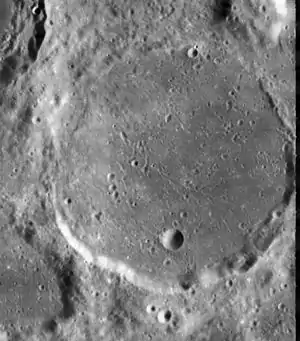Lamb (crater)
Lamb is a lunar crater that lies beyond the southeastern limb on the Moon's far side. It is located in an irregular lunar mare region named Mare Australe, just to the east of the crater Jenner.
 Lunar Orbiter 4 image | |
| Coordinates | 42.9°S 100.1°E |
|---|---|
| Diameter | 106 km |
| Depth | Unknown |
| Colongitude | 262° at sunrise |
| Eponym | Horace Lamb |
This crater has a slender inner wall and an interior floor that has been resurfaced by basaltic lava. The rim is somewhat worn and irregular, but retains a generally circular shape and is not overlaid by any smaller craters of significance. The interior floor is marked only by a multitude of tiny craters, and a small, unnamed crater in the south-southeastern section.

The exterior of the crater consists of the outer rampart and sections of rough terrain. This in turn is nearly enclosed by lava-flooded sections of the surface belonging to the Mare Australe. To the east of Lamb is Lamb G, a somewhat smaller, lava-flooded formation.
The crater is named after Sir Horace Lamb, an English mathematician.
Satellite craters
By convention these features are identified on lunar maps by placing the letter on the side of the crater midpoint that is closest to Lamb.
| Lamb | Latitude | Longitude | Diameter |
|---|---|---|---|
| A | 39.9° S | 101.6° E | 20 km |
| E | 41.6° S | 107.1° E | 11 km |
| G | 43.2° S | 105.9° E | 69 km |
References
- Andersson, L. E.; Whitaker, E. A. (1982). NASA Catalogue of Lunar Nomenclature. NASA RP-1097.CS1 maint: ref=harv (link)
- Blue, Jennifer (July 25, 2007). "Gazetteer of Planetary Nomenclature". USGS. Retrieved 2007-08-05.CS1 maint: ref=harv (link)
- Bussey, B.; Spudis, P. (2004). The Clementine Atlas of the Moon. New York: Cambridge University Press. ISBN 978-0-521-81528-4.CS1 maint: ref=harv (link)
- Cocks, Elijah E.; Cocks, Josiah C. (1995). Who's Who on the Moon: A Biographical Dictionary of Lunar Nomenclature. Tudor Publishers. ISBN 978-0-936389-27-1.CS1 maint: ref=harv (link)
- McDowell, Jonathan (July 15, 2007). "Lunar Nomenclature". Jonathan's Space Report. Retrieved 2007-10-24.CS1 maint: ref=harv (link)
- Menzel, D. H.; Minnaert, M.; Levin, B.; Dollfus, A.; Bell, B. (1971). "Report on Lunar Nomenclature by the Working Group of Commission 17 of the IAU". Space Science Reviews. 12 (2): 136–186. Bibcode:1971SSRv...12..136M. doi:10.1007/BF00171763.CS1 maint: ref=harv (link)
- Moore, Patrick (2001). On the Moon. Sterling Publishing Co. ISBN 978-0-304-35469-6.CS1 maint: ref=harv (link)
- Price, Fred W. (1988). The Moon Observer's Handbook. Cambridge University Press. ISBN 978-0-521-33500-3.CS1 maint: ref=harv (link)
- Rükl, Antonín (1990). Atlas of the Moon. Kalmbach Books. ISBN 978-0-913135-17-4.CS1 maint: ref=harv (link)
- Webb, Rev. T. W. (1962). Celestial Objects for Common Telescopes (6th revised ed.). Dover. ISBN 978-0-486-20917-3.CS1 maint: ref=harv (link)
- Whitaker, Ewen A. (1999). Mapping and Naming the Moon. Cambridge University Press. ISBN 978-0-521-62248-6.CS1 maint: ref=harv (link)
- Wlasuk, Peter T. (2000). Observing the Moon. Springer. ISBN 978-1-85233-193-1.CS1 maint: ref=harv (link)
